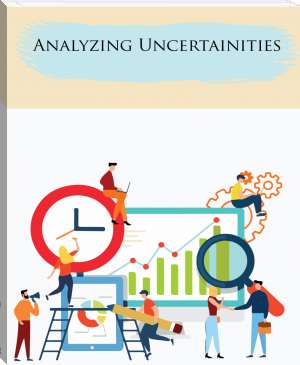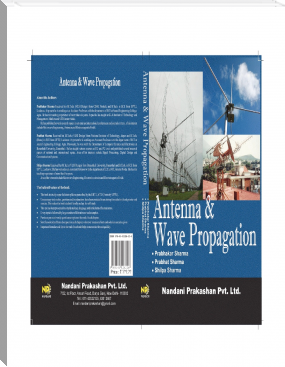Analyzing Uncertainties by Tehzun Kachwala, Kettan Sharma, Pratik Patil, Gurjinder Singh (top reads TXT) 📖

- Author: Tehzun Kachwala, Kettan Sharma, Pratik Patil, Gurjinder Singh
Book online «Analyzing Uncertainties by Tehzun Kachwala, Kettan Sharma, Pratik Patil, Gurjinder Singh (top reads TXT) 📖». Author Tehzun Kachwala, Kettan Sharma, Pratik Patil, Gurjinder Singh
Risk management is an ongoing factor which cannot be ignored through the project life cycle. It is an entirely broad topic to discuss. Management of risks include planning, identifying, executing the decided strategies monitoring and controlling uncertainties. Occurrence of risk is uncertain and new risks can be identified any time during project life cycle, it is the motive of risk management to identify uncertainties and decrease its probability and impact on a project if risks are negative and increasing the probability if risks are positive. As project risks can have both positive and negative impact, they must be treated in the required way, risks having positive impact should be exploited or enhanced depending upon the opportunities whereas risks having negative impact should be avoided or mitigated or accepted or transferred depending upon the risk scenario.
Risk in project management is defined as an uncertain event which has positive or negative effect on the project altogether. Risk can have multiple reasons to occur in which few risks can be categorized before time and few risks can be uncertain. For example, we can assume that Bank of North America (BONA) is partnering with Java Coffee Beans to launch a co-branded loyalty credit card. Where the loyalty portion of Java Coffee Beans (JCB) allows customers 2% of cash back on each purchase. In this scenario we can consider many predefined and uncertain risk, such as faulty credit card supplied by the supplier, other banks launch credit card before Bank of North America or inflation in market. If either of these uncertain events occur, we can have a huge impact on our project scope.
Management of risks is series of steps taken to identify the risks, categorize them, quantification of risks, implementing the decided risk responses, monitoring risks, implementing contingency or fallback plans in case of strategies doesn’t work out and could be major threat to the organization, if not applied with a workaround in such situations. The most common approach in identifying risks is to manage the individually recorded risk and asses them in the project risk register. There are two approaches to risk analysis qualitative and quantitative. Analyzing risk provides a comprehensive method to determine project success. Process of assessing risk and analyzing it can also be a huge part of project success.
Qualitative risk analysis is the process of individually assessing characteristics of project risk and its impact on the project whereas Quantitative risk analysis is numerically analyzing the probability and impact of risks ranked highest in qualitative risk analysis. In this book we will be talking about how to analyze risk by doing its qualitative and quantitative analysis in depth. It is likely that certain things will not go according to the plan in the project lifecycle. To stay in control of the project you need to carry out steps to manage project risks and continuously keep your eye on the risk if it emerges with noticeable impact or not, even after it has been implemented with a strategic risk response. Also, planning the risk responses, keep in mind the secondary risks associated with each risk response is also very important as monitoring the risks are. The book is designed in a way to touch all the important aspects of risk management.
Plan Risk management
Plan risk management is the first process in planning process group which covers the risk management knowledge area. It outlines the approach and tools/techniques, or methods used for risk management in a specific project under consideration. The process is performed at required points in the project life cycle to ensure that an effective approach and methods of risk management are being followed to make the project successful.

Table Plan risk management Inputs, Tools & Techniques, and Outputs
The above table is taken from PMBOK sixth edition, showing the inputs, tools and techniques and outputs of the process being discussed.
Why is the project charter an Input to plan risk management?
Project charter includes high level information of the project i.e. who are the key stakeholders, assumptions, risks identified in the initial phase, project scope statement, issues and other factors those might emerge out to be a risk to other project management knowledge areas
Why is the project management plan an Input to plan risk management?
Project management plan includes other management plans. For example, cost management plan, schedule management plan, scope management plan or any other which might be on the verge of any risk to the project period.
Why are project documents an input to plan risk management?
Project documents include stakeholders register which contains the overview of the roles in the project and helps in identifying their power/interest/influence in the project. Knowing the all-important stakeholders helps in determining the risk management roles and responsibility in the project
Why are enterprise environmental factors included as an Input to plan risk management?
Key stakeholders or the organization set the overall risk thresholds to the project, hence enterprise environmental factors can influence the project
Why is organizational process assets included in Input to plan risk management?
Project risk management can be influenced by Organizations’ approach and methodology to risks, lessons learned data of the organization, roles and responsibility of the key stakeholders in the organization, risk categorization and formatting of risk statements, templates provided by the organization as it requires specific set of data requirements.
Tools and techniques used
Expert judgement-
Individuals or group of individuals familiar with organizational risk management framework and policies & procedures help in tailoring the risk management process according to project’s needs
Data analysis-
Stakeholders register contains the list of all the key stakeholders and an analysis is conducted on the stakeholders in order to know about risk appetite of all stakeholders
Meetings –
Meetings are an integral part of the projects and are conducted from the very beginning. In the form of project kick-off meeting and at several points including key stakeholders like project manager, project team, key stakeholders, experts or people outside or external to the organization to help share their knowledge and experience in shaping risk management process according to different risks at that instant
Outputs-
Risk management plan is the output of the process. This document documents important documents those may include but not limited to-
Risk strategy and methodology which tells about the overall risk management approach throughout the project and how much effort for a project is required in an organization respectively
For example- A low priority project requires less effort than a high priority project hence the methodology will define how risk management should be performed to meet the needs of the project
Roles and responsibilities describe who will be responsible for what kind of risk management tasks
Risk categories ensure that an important area in the possible risks is not missed
For example: risks can be internal, external, technical, commercial or any other category
Stakeholders appetite tells about how much risk a stakeholder can accept or bear
Identifying Risks
Managing risks properly is an art, but before managing them the risks needs to be identified. According to the project management book of knowledge (PMBOK) there are many common techniques to identify risk such as experience based, brainstorming making checklists, assumption log, cause and effect diagram and few more.
Experience Based Risk- To be successful in project management as a project manager or project management professional one needs to gain knowledge from past experiences both organizationally and personally. One needs to understand the importance of risk management, unmanaged or unmitigated risk can be a big reason, so noting the past learned risk or remembering the past risk is an asset.
One of the authors experiences as a manager of a software development firm for many years, his experience says that continued relearning is always required to be successful in project management and what can be better than learning from past experiences? Why isn’t this information readily available to the new project managers? He personally feels that many project managers or project management professional do not implement this and avoid writing down their past experiences or trying to learn from someone else’s past experiences as a result of which they fail in managing projects.
Brainstorming- It is a simple session between the team members to generate as many ideas as possible to find a solution to the problem. It is a situation where group together generates ideas to find solution for a specific problem. In a brainstorming session all the ideas are mainly noted to be evaluated later.

Figure :Group of people doing “Brainstorming”
Checklist- It is a list of analyzed risk from past experiences. Most organizations have such checklist if not one has to be created. After the end of every project a post review of project is conducted, and list of significant risks maybe stored which can be used for upcoming projects, although checklist is considered to be great piece of information but they do not contain all the list of risk.

Figure :Checklist
Assumption Log
The risks in a project which are real or certain without any proof of demonstration are called Assumptions. An assumption log is simply a place to store or track all the assumptions related to project. In this case project team manager should discuss the assumptions of risks which will then be further logged in the assumption log. Assumption log is further created by a project manager.

Table : Assumption log
Cause and Effect Diagram- Cause and effect diagrams are powerful and the simplest ways to identify risks. Project managers can use such diagrams to give a rise to… identified risks through which we can either reduce them or eliminate them. An Ishikawa diagram also known as Fishbone diagram can be used as cause and effect diagram.
Figure Ishikawa or Fishbone Diagram
Classification of Risks- In the real-world identifying risks and then classifying is a must as we do not have that much time, money or resources to later deal with them. Management must make sure that they either mitigate or have a contingency plan to reduce or eliminate risks. To implement this first the risks must be classified and then those risks must be prioritized. All the risks then must be examined to find out its category, severity and its impact. For example, risks from the Bank of North America and Java Beans project have been identified, classified and then prioritized in the tables below:
Table List of Risk

Table Risk Categorization


 The desire to acquire knowledge about the surrounding world and human society is quite natural and understandable for a person. Life is so developed that an uneducated person will never occupy a high position in any field. Humanity in its mass, and each person individually, develops objectively, regardless of certain life circumstances and obstacles, but with different intensity. The speed of development depends on the quality of training.
The desire to acquire knowledge about the surrounding world and human society is quite natural and understandable for a person. Life is so developed that an uneducated person will never occupy a high position in any field. Humanity in its mass, and each person individually, develops objectively, regardless of certain life circumstances and obstacles, but with different intensity. The speed of development depends on the quality of training.




Comments (0)